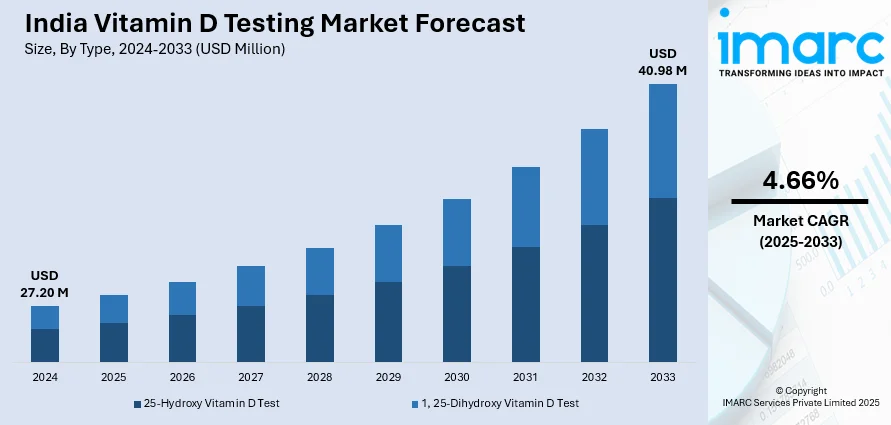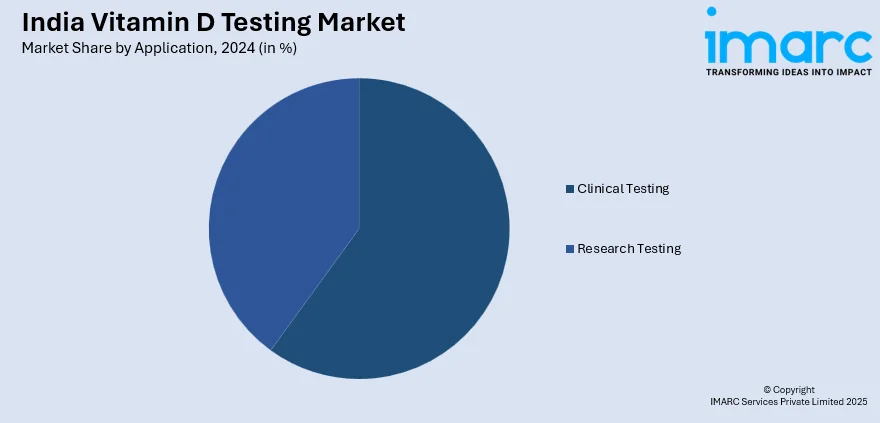
India Vitamin D Testing Market Size, Share, Trends and Forecast by Type, Technique, Indication, Patient, Application, End User, and Region, 2025-2033
India Vitamin D Testing Market Overview:
The India vitamin D testing market size reached USD 27.20 Million in 2024. Looking forward, IMARC Group expects the market to reach USD 40.98 Million by 2033, exhibiting a growth rate (CAGR) of 4.66% during 2025-2033. The escalating cases of vitamin D deficiency, continuous advancements in diagnostic technologies, increasing prevalence of chronic diseases linked to vitamin D deficiency, and expanding healthcare infrastructures are among the key factors driving the India vitamin D testing market.
|
Report Attribute
|
Key Statistics
|
|---|---|
|
Base Year
|
2024
|
|
Forecast Years
|
2025-2033
|
|
Historical Years
|
2019-2024
|
| Market Size in 2024 | USD 27.20 Million |
| Market Forecast in 2033 | USD 40.98 Million |
| Market Growth Rate 2025-2033 | 4.66% |
India Vitamin D Testing Market Trends:
Changing Lifestyles Leading to Increased Deficiency Cases
India is witnessing rapid urban migration, as more people are coming to urban areas for better employment opportunities and standards of living. In 2011, 31.16% of India's population lived in urban areas, and projections suggest that by 2030, over 40% of the population will live in cities. While urbanization has economic advantages, it also results in less outdoor activity, which is essential for natural vitamin D production. In urban cities such as Delhi, Mumbai, and Bengaluru, people tend to spend long periods indoors on account of office work, work-from-home, or studies. Consequently, their exposure to sunlight, which is critical for the body's natural production of Vitamin D, substantially decreases. Furthermore, urban air pollution also intensifies the situation. Dense smog and heavy air pollution screen UVB rays, which are needed for the synthesis of Vitamin D. As such, people in very polluted cities have lower Vitamin D levels than those in rural communities with clean air and high exposure to sun.

To get more information of this market, Request Sample
Technological Advancements in Diagnostic Testing
Yet another major driver of India's vitamin D testing market is the rapid innovations in diagnostic technologies. Earlier, vitamin D tests used to involve elaborate laboratory procedures, which were lengthy and equipment-dependent, usually restricted to remote regions. Current innovations have brought about a significant change. The invention of point-of-care test kits has made vitamin D testing more convenient and accessible. These test kits provide instant results of high accuracy and eliminate the necessity of sophisticated lab conditions. In line with this, there has been a growing uptake of the point-of-care test kits, as they require less professional consultation and are easily usable. Besides this, the integration of electrochemical biosensors and liquid chromatography-mass spectrometry has increased the accuracy of vitamin D testing. These developments have facilitated early detection of deficiencies, which in turn results in timely medical intervention and improved patient outcomes. Moreover, automated immunoassays and nanotechnology-based detection systems have further simplified the process, lowering costs and turnaround times. These developments are especially useful in rural regions, where access to conventional lab-based testing is limited.
India Vitamin D Testing Market Segmentation:
IMARC Group provides an analysis of the key trends in each segment of the market, along with forecasts at the region/country level for 2025-2033. Our report has categorized the market based on type, technique, indication, patient, application and end user.
Type Insights:
- 25-Hydroxy Vitamin D Test
- 1, 25-Dihydroxy Vitamin D Test
The report has provided a detailed breakup and analysis of the market based on the type. This includes 25-hydroxy vitamin D test and 1, 25-dihydroxy vitamin D test.
Technique Insights:
- Radioimmunoassay
- ELISA
- HPLC
- LC-MS
- Others
A detailed breakup and analysis of the market based on the technique have also been provided in the report. This includes radioimmunoassay, ELISA, HPLC, LC-MS, and others.
Indication Insights:
- Osteoporosis
- Rickets Thyroid Disorders
- Malabsorption
- Vitamin D Deficiency
- Others
A detailed breakup and analysis of the market based on the indication have also been provided in the report. This includes osteoporosis, rickets thyroid disorders, malabsorption, vitamin D deficiency, and others.
Patient Insights:
- Adult
- Pediatric
A detailed breakup and analysis of the market based on the patient have also been provided in the report. This adult and pediatric.
Application Insights:

- Clinical Testing
- Research Testing
A detailed breakup and analysis of the market based on the application have also been provided in the report. This includes clinical testing and research testing.
End User Insights:
- Hospitals
- Diagnostic Laboratories
- Home Care
- Point-of-Care
- Others
A detailed breakup and analysis of the market based on the end user have also been provided in the report. This includes hospitals, diagnostic laboratories, home care, point-of-care, and others.
Regional Insights:
- North India
- South India
- East India
- West India
The report has also provided a comprehensive analysis of all the major regional markets, which include North India, South India, East India, and West India.
Competitive Landscape:
The market research report has also provided a comprehensive analysis of the competitive landscape. Competitive analysis such as market structure, key player positioning, top winning strategies, competitive dashboard, and company evaluation quadrant has been covered in the report. Also, detailed profiles of all major companies have been provided.
India Vitamin D Testing Market News:
- December 2024: Horlicks Women's Plus partnered with Apollo Diagnostics to offer vitamin D tests at over 2,000 centers across 200 Indian cities for INR 199, significantly lower than the standard INR 1,850 fee. This initiative aims to raise awareness about vitamin D deficiency among women, encouraging early detection and preventive healthcare. By making testing more accessible and affordable, the collaboration is expected to drive growth in India's vitamin D testing market.
- March 2024: Unimoni Financial Services Ltd. organized free vitamin D blood test and BMI check-up camps across 12 Indian states, attracting over 900 participants. This initiative raised awareness about vitamin D deficiency, leading to increased public interest in testing.
India Vitamin D Testing Market Report Coverage:
| Report Features | Details |
|---|---|
| Base Year of the Analysis | 2024 |
| Historical Period | 2019-2024 |
| Forecast Period | 2025-2033 |
| Units | Million USD |
| Scope of the Report |
Exploration of Historical Trends and Market Outlook, Industry Catalysts and Challenges, Segment-Wise Historical and Future Market Assessment:
|
| Types Covered | 25-Hydroxy Vitamin D Test, 1, 25-Dihydroxy Vitamin D Test |
| Techniques Covered | Radioimmunoassay, ELISA, HPLC, LC-MS, Others |
| Indications Covered | Osteoporosis, Rickets Thyroid Disorders, Malabsorption, Vitamin D Deficiency, Others |
| Patients Covered | Adult, Pediatric |
| Applications Covered | Clinical Testing, Research Testing |
| End Users Covered | Hospitals, Diagnostic Laboratories, Home Care, Point-of-Care, Others |
| Regions Covered | North India, South India, East India, West India |
| Customization Scope | 10% Free Customization |
| Post-Sale Analyst Support | 10-12 Weeks |
| Delivery Format | PDF and Excel through Email (We can also provide the editable version of the report in PPT/Word format on special request) |
Key Questions Answered in This Report:
- How has the India vitamin D testing market performed so far and how will it perform in the coming years?
- What is the breakup of the India vitamin D testing market on the basis of type?
- What is the breakup of the India vitamin D testing market on the basis of technique?
- What is the breakup of the India vitamin D testing market on the basis of indication?
- What is the breakup of the India vitamin D testing market on the basis of patient?
- What is the breakup of the India vitamin D testing market on the basis of application?
- What is the breakup of the India vitamin D testing market on the basis of end user?
- What are the various stages in the value chain of the India vitamin D testing market?
- What are the key driving factors and challenges in the India vitamin D testing market?
- What is the structure of the India vitamin D testing market and who are the key players?
- What is the degree of competition in the India vitamin D testing market?
Key Benefits for Stakeholders:
- IMARC’s industry report offers a comprehensive quantitative analysis of various market segments, historical and current market trends, market forecasts, and dynamics of the India vitamin D testing market from 2019-2033.
- The research report provides the latest information on the market drivers, challenges, and opportunities in the India vitamin D testing market.
- Porter's five forces analysis assist stakeholders in assessing the impact of new entrants, competitive rivalry, supplier power, buyer power, and the threat of substitution. It helps stakeholders to analyze the level of competition within the India vitamin D testing industry and its attractiveness.
- Competitive landscape allows stakeholders to understand their competitive environment and provides an insight into the current positions of key players in the market.
Need more help?
- Speak to our experienced analysts for insights on the current market scenarios.
- Include additional segments and countries to customize the report as per your requirement.
- Gain an unparalleled competitive advantage in your domain by understanding how to utilize the report and positively impacting your operations and revenue.
- For further assistance, please connect with our analysts.
 Request Customization
Request Customization
 Speak to an Analyst
Speak to an Analyst
 Request Brochure
Request Brochure
 Inquire Before Buying
Inquire Before Buying




.webp)




.webp)












